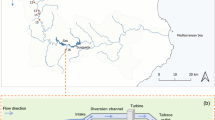Abstract
Phenotypic plasticity in morphology is often considered adaptive. Stream-living fish encounter considerable spatial and temporal environmental variation in their native habitats, and the ability to adapt to this variation is of utmost importance. We studied experimentally whether water velocity affects the body shape of juvenile Atlantic salmon (Salmo salar m. sebago Girard) and brown trout (Salmo trutta m. lacustris L.). The fish were reared in slow and fast water flow, and their morphology was studied by measuring a number of morphometric characters. We studied which characters differed between the environments in each species, and found that water velocity caused morphological differentiation in both salmon and brown trout. The differences occurred especially in body height as well as in fin sizes, characters that are very likely to be of functional importance for life in the stream environment. Salmon in fast flow became more robust, whereas brown trout in fast flow became slightly more streamlined. The observed variation in body morphology of salmon and brown trout indicates phenotypic plasticity, but the species differed in their response to environmental variation, which may be due to different energetics and cost reduction strategies. Morphological differentiation caused by water flow occurred very rapidly, within 1-month exposure to the different water flows.
Similar content being viewed by others
Author information
Authors and Affiliations
Rights and permissions
About this article
Cite this article
Pakkasmaa, S., Piironen, J. Water velocity shapes juvenile salmonids. Evolutionary Ecology 14, 721–730 (2000). https://doi.org/10.1023/A:1011691810801
Issue Date:
DOI: https://doi.org/10.1023/A:1011691810801




